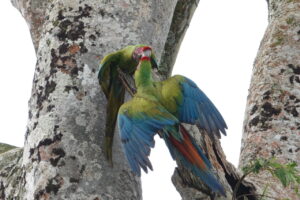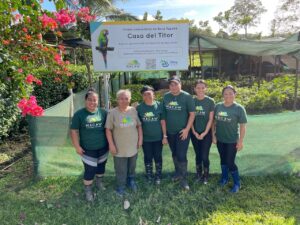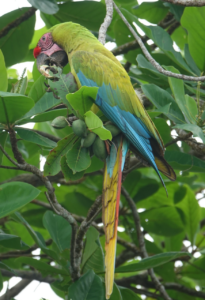
The Republic of Costa Rica in Central America is known for its incredible biodiversity. The people, known to themselves as “Ticos,” have elected to honor and protect their native lands and animals through their laws and national parks. This desire to respect nature and its many species is now embedded in their culture. The population has a 97% literacy rate because they also highly value education, a decently paid workforce, and a stable democracy. It is an amazing country, a global model in many ways. In 2017, National Geographic named Costa Rica as the happiest country in the world. Pura Vida, literally meaning pure life, is a common phrase amongst the Ticos.
Costa Rica is also geographically interesting because it borders the Caribbean Sea to the east and the Pacific Ocean to the west. Between shores, there are mountains, and active volcanoes, and a quarter of the central area is comprised of protected jungles. It has a year-round tropical climate, with wet and dry seasons. Ecotourism is a major industry in Costa Rica for good reason, and it remains one of the safest countries in Latin America for travel. English is widely spoken.
Home to the Great Green Macaw
Costa Rica is also home to the magnificent Great Green Macaw (Ara ambiguus), the second largest parrot to the hyacinth macaw. It is red-listed as critically endangered by the IUCN. There are only an estimated 500-1000 Great Greens remaining in the world, with about half of those being on the eastern side of Costa Rica. There are a few smaller groups in parts of Nicaragua, Panama, Columbia, and Honduras.
When I was in Costa Rica in 2000, the Great Green macaw was highly endangered and only a couple hundred supposedly remained in the wild. An American couple, Margo and Rich Frisius, were doing their best to help recover the species under an organization they created called Amigo de los Aves. This organization has since changed leadership and names several times, but it has now been subsumed under the Macaw Recovery Network (MRN). MRN is working hard to grow the Great Green and Scarlet Macaw populations, and it’s making some remarkable strides!
Planting the Seeds of Hope

One of the biggest challenges to the survival of the Great Green is access to mountain and sea almond trees, used for food and nesting during the breeding season, which is from December to June. The lowland forests were largely decimated decades ago for farming and cattle land. So, the macaws often need to fly long distances to find sufficient food. María Elena Munguía Jiménez, a volunteer for the MRN, had a brilliant idea. After monitoring macaw nests for six months, she saw through simple observation that the parents needed to go farther and farther away to find food to feed their chicks. She suggested that if trees were planted closer to nesting areas, they would not have to fly up to 40 kilometers for sufficient food sources. In 2021, six women began germinating the mountain and sea almond trees in their homes, and in 2022 the local government gave them permission to build a nursery in Boca Topada. Thus began the nurseries managed by the Women Rangers. Their laudable goal is to raise 7,000 trees by mid-2024, each of which has been tenderly planted and nurtured in their nurseries.

Photo by Angie Yeung Celltei®
During the non-breeding season, the Titor tree is also an essential source of food. The Titor is much harder to germinate and takes a long time to grow. It is not protected by the government like the mountain and sea almond trees, so MRN is asking farmers in the lowlands to plant more of these because food, more than habitat, may be the key to the survival of young macaws. Reforestation takes time, and for some trees, decades.
In February 2023, a group of Phoenix Landing volunteers had the privilege of meeting Mario Jiménez Segura, MRN’s Field Team Leader, and visiting the Women Rangers. Their dedication and enthusiasm are impressive! We were each allowed the opportunity to plant seedlings into pots as a token of our support and appreciation. And the good news – the Great Greens are making a comeback, but what they most need are more reforested areas. Starting in 2022, conservation groups are making a concerted effort to work together across borders to take an annual census during the non-breeding season by searching for roosting areas and counting the number of birds. In addition, people in Costa Rica are encouraged to report all Great Green sightings to MRN. We hope for even better news about their population increase in future years. Meanwhile, the Women Rangers are doing their part by planting the trees needed to sustain a growing macaw population!
Lafeber’s GLOBAL PARROT grant this month goes to support the continued repopulation of the Great Green Macaws of Costa Rica, specifically for the essential nursery and reforestation work by MRN’s Women Rangers. If you would also like to help or learn more, go to: https://macawrecoverynetwork.org/seeds-saplings-and-sowing/






We can all contribute with Parrot conservation. Many thanks to Phoenix Landing for all your passion & love for macaws that is contagious.
Thank you to all of the Tico’s and others who are helping save this beautiful species of macaw. I’m so sorry to hear that numbers are declining but heartened that work and effort is happening to halt that decline.
Fabián Guzmán, from Tropical Trace, was our expert guide. Not only is he compassionate and well versed about the great diversity of animals and plants of Costa Rica, but he makes travelling a most fun and adventurous experience!